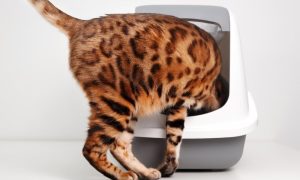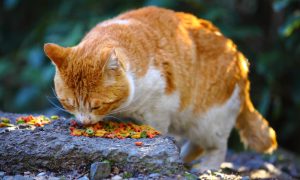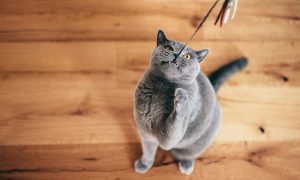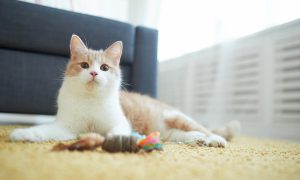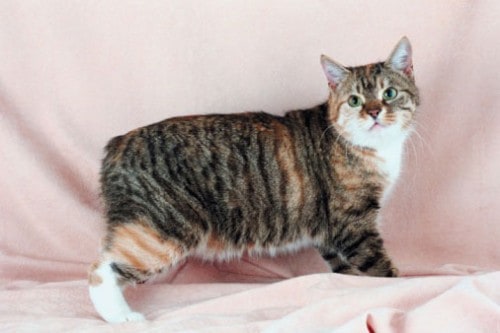 Came ashore the Isle of Man in Great Britain during the end of 16th Century was a rather restricted gene pool of feline population that is generally set apart for its compact, stocky look and little “stub” of tail which is sorted into four kinds: dimple rumpy, rumpy riser, stumpy or partial tail, and longy or tailed. This rounded and powerfully built medium-sized breed is known as the Manx cat. It has a broad chest, short back, longer hind legs and a hopping (and even rabbit-like) way of walking. Not to mention its remarkably strong facial features characterized by a pair of large eyes, prominent ears, wide, straight muzzle and full jowly cheeks. A true Manx cat is tailless, and it can unveil either of the two soft, plush coat varieties: (1) short and dense with coarser outer coat, and (2) long and silky with neck and belly ruffs. This adorable breed normally comes in a wide array of acceptable coat colors and patterns including black, black tipped, white, silver tabby, and brown spotted.
Came ashore the Isle of Man in Great Britain during the end of 16th Century was a rather restricted gene pool of feline population that is generally set apart for its compact, stocky look and little “stub” of tail which is sorted into four kinds: dimple rumpy, rumpy riser, stumpy or partial tail, and longy or tailed. This rounded and powerfully built medium-sized breed is known as the Manx cat. It has a broad chest, short back, longer hind legs and a hopping (and even rabbit-like) way of walking. Not to mention its remarkably strong facial features characterized by a pair of large eyes, prominent ears, wide, straight muzzle and full jowly cheeks. A true Manx cat is tailless, and it can unveil either of the two soft, plush coat varieties: (1) short and dense with coarser outer coat, and (2) long and silky with neck and belly ruffs. This adorable breed normally comes in a wide array of acceptable coat colors and patterns including black, black tipped, white, silver tabby, and brown spotted.
Temperament
Despite the line’s breeding challenges and physical difficulties, a lot of people still find Manx cats irresistible. Active, intelligent, and fun-loving, this breed commonly makes wonderful companions at home because of their ability to adapt easily. They can form strong bonds with their human family and can even get along well with other household pets, especially dogs. However, due to their powerful hind legs, Manx cats are said to be incomparable jumpers. No wonder, no shelf or cupboard is perfectly safe with this adorable steeplechaser around. Although, this lively cat is rather mischievous at times, you can still count on them when it comes to curling up with you for some heart-warming snuggle.
Health Concerns
Purebred Manx cats can become fit and healthy felines, manifesting hardly any signs of aging as they get older. Nevertheless, breeding this line can be rather frustrating due to its tendency to have small litters. Not to mention the possibility that the kittens or some of them will have tails of differing length (which is surely not acceptable in the show ring). Aside from that, due to its abnormal spinal structure, Manx cats are also prone to a condition called spina bifida. The breed is also at risk of developing health issues like sacrocaudal dysgenesis, rectal prolapse, progressive corneal dystrophy, and urinary incontinence. Even problems like megacolon, rump fold intertrigo, and constipation are not an exception.
Best Environment
Since most extremely energetic cats, like the Manx cat, love to jump to high spots, you would have to keep breakable objects off your open shelves. The breed thrives well in an indoor living setup with lots of scratching posts to entertain themselves. In order to promote a safe and healthy, long life for this line, breeders highly recommend that Manx cats are kept in the house.








